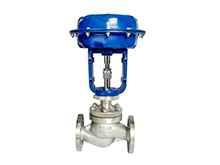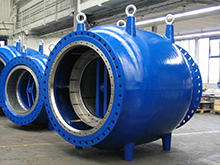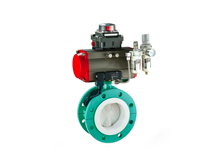
Angle Seat Valve
Features:
Size: 1/2”-2”
Pressure Rating: PN10-PN40,150LB-300LB
Material: Stainless Steel
Design Standard: API6D,ASME B16.34
Inspection Standard: API598
Application medium: water, oil, powder
Application Temperature: 0-200℃
We're here to help:
Easy ways to get the answers you need.
Parameter:
Angle seat valves are 2/2-way pneumatically actuated piston valves. The piston actuator provides a linear motion to lift the seal off its seat. Because the seat is positioned under an angle, the flow is minimally impeded in the open position, resulting in an excellent flow rate and a low pressure loss. They are used to regulate the flow of liquids, gases, steam, vacuum and even aggressive fluids. They can also operate with high temperatures and high viscosity media, even under zero differential pressures.
The robust design makes angle seat valves a popular choice for harsh applications and they have very high cycle lives. Therefore, they are excellent long-life alternatives to ball valves. These valves are also suitable alternatives for solenoid valves, especially with contaminated, viscous media where typical solenoid valves would fail. They may be operated using a single acting or double acting configuration, which has an influence on its pressure rating. They can also be designed as manually operated or electrically operated, but in this article we will discuss pneumatic angle seat valves.
Construction and Design
They have a robust construction similar to globe valves, but use a piston operated angle seat valve with a closure spring. The body is normally cast or die-forged in one piece. A plug is connected to the end of the piston which is seated on PTFE seats. The piston is designed to retract further from the seat, thereby providing maximum flow rate. They may be Normally Closed (NC), Normally Open (NO) or Double Acting. The piston actuator comes with threaded ports or with NAMUR ports which allows for direct mounting of NAMUR style solenoid valves.
Often, the actuator head can be rotated 360° to allow optimum position of air and electric lines in tight locations. The valve body is generally made of brass or stainless steel. Connection types include threaded, clamped or welded. Typically, a visual indicator on the top of the piston shows whether the valve is open or closed.
WESDOM Advantages
1.WESDOM patent products, patent certification
The product side flanges comply with national, German, Russian, American, British and Japanese standards and other domestic and international standards for multiple pressures, easy connection and wide adaptability, which can reduce the type of purchase and stock.
2.The product has an independent identity to ensure traceability
Each wesdom product has its own unique identification number, to ensure product traceability.
3.Provide material inspection report
All wesdom products can provide the material inspection report of the main parts.
4.One-stop service
One-stop service, we not only supply high quality products, also supply solutions and after-sales service.
5.WESDOM has a lot of project experience
We have a lot of project experience in countries such as Pakistan and the Philippines, WESDOM has always been noticed all over the world, and trust comes from quality.
6. WESDOM has a strict quality control system
WESDOM has a strict quality control system and before delivery, we test 100% of each product to ensure its quality, promising you a high quality product.
Quality Control Process
Standards&Features:
Working Principle
Angle seat valves are operated pneumatically such that air pressure is used to control the piston actuator, which lifts the valve plug off its seat. Normally Closed (NC) valves usually have the valve closed in unpressurized conditions and use a spring to return the valve to the rest state. Normally Open (NO) valves have the valve opening always open unless air pressure acts to close it. A NO valve can be obtained if the spring is placed on the opposite side of the piston actuator. Double Acting valves can be used to handle flow in both directions. These valves have no spring and depend on the supply air to determine the valve position. These configurations influence the pressure rating of the valve.
Flow up and under the valve (causing valve to open) will reduce water hammer effect but reduces the maximum working pressure of the valve by typically 50%. However, fitting a strong return spring will help increase the working pressure but a larger actuator will be required to overcome this increased spring strength. With flow over seat (causing valve to close), a full working pressure is achieved and water hammer can be reduced by restricting the compressed air supply flow.
Controlling the angle seat valve with a solenoid valve
Normally, a three-way solenoid valve is used to operate NC or NO angle seat valves. These angle seat valves have one connection port to the piston chamber. The solenoid valve controls whether the chamber is pressurized or vented. Double acting angle seat valves have two connection ports and cannot be controlled with a single three-way valve. They can be controlled by a five-way solenoid valve that can pressurize one port while venting the other, and vice versa.
Angle seat valve selection
End Connections and Line Size
Angle seat valves are available in a wide range of sizes and end connections. The most commonly available valves have size from 1/2 to 3 BSP or NPT threads. Some manufacturers provide flange options. The nominal diameter (DN) of the valve seat helps to select the right size, but most manufacturers specify the Kv-value, which is a more reliable parameter to select the proper size. The Kv-value is a measure of the flow rate of water at a pressure drop of 1 bar. If the media characteristics, the pressures and the Kv-value are known, the flow rate can be calculated with a formula. With the help of our Valve sizing calculator, it is easy to determine the minimum required Kv-value for your application. Using the right valve size facilitates high and efficient flow with less chances of wear and leakage.
Operating Temperature, Pressure and material properties
Typically, the maximum working pressure lies in the range of 5 to 20 bar. Not only the pressure of the media has to be taken into account, also the pressure (range) of the compressed air circuit has to be taken into account. They can handle temperatures up to 200 °C using PTFE (Teflon) sealing. Other sealing materials include NBR (Nitrile Buna Rubber), FKM (Viton) and EPDM, which usually have a lower temperature rating. The temperature and pressure rating is also affected by the housing material. Typical housing materials include bronze, 314 or 316 stainless steel, brass, plastic and gunmetal. Of these materials, stainless steel offers the best corrosion resistance and material strength. Therefore, most of the high pressure or high temperature angle seat valves have a stainless-steel housing with PTFE seals. The piston housing can be made of the same material as the valve body, but some have a plastic housing instead to save weight or production costs.
Case:
Pakistan AL-MORIZE Sugar Factory
Main products:
Control/On-off butterfly valves, Control globe valves, Control ball valves, Angle seat valves.
The customer found WESDOM through Google advertisements, because he himself is relatively familiar with valves, so he sent the required products, product materials and required medium to our salesman in the international trade department, and the WESDOM salesman also promptly contacted with our factory's sales department and the engineering department, and then gave the customer the best price;
Client feedback:
WESDOM's valves are not only of high quality, but also of very good service and price. At the same time, you can also customize your own logo and color. The delivery time is very punctual. They are very satisfied with the cooperation with WESDOM, and they will choose WESDOM if you need it;
Project pictures:
Application:
These valves can be used to deliver millions of cycles of operation in demanding applications such as steam, water and aggressive media. They are ideally suited for vacuum applications and can be used in fast acting applications up to 1000 cycles per hour with expected life of over 10 million cycles. They are used in many industries, including food & beverage, chemical, oil & gas, water & sewage etc.
Please fill in your procurement needs and contact information
















